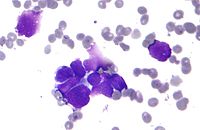
Photo from wikipedia
Achieving the pathological type diagnosis of pulmonary nodules on chest CT is a critical step in the early detection of lung cancer and treatment of patients. Based on a small… Click to show full abstract
Achieving the pathological type diagnosis of pulmonary nodules on chest CT is a critical step in the early detection of lung cancer and treatment of patients. Based on a small and unbalanced self-constructed dataset, we achieved intelligent diagnosis of five pathological types including adenocarcinoma, squamous cell carcinoma, small cell carcinoma, inflammatory and other benign diseases for the first time. In order to reduce the dependence of deep convolutional neural network (DCNN) on a large amount of training data, a reverse adversarial classification network (RACN) was proposed based on semi-supervised learning, which consists of a reverse generative adversarial network (RGAN) for unsupervised regression and a supervised classification network (CN). In RGAN, five specific normal distributions P with different means and variances were assigned to represent the five pathological types, and then a special regression task was designed by mapping pulmonary nodules to the random sampling Z of P. The input of generator in RGAN is set to 3D nodule volume data, the inputs of discriminator are set to Z and the output of generator. The regression task enables RGAN to extract specific features, which will be deeply integrate into CN to improve the classification performance. Experiments showed that the average sensitivity of RACN in detecting malignant nodules was 0.6525, where the sensitivity of adenocarcinoma, small cell carcinoma and squamous cell carcinoma was 0.8426, 0.5604 and 0.5543. Besides, the RACN can achieve 93.21% accuracy for diagnosing malignant nodules on the public LIDC-IDRI dataset, obtaining the state-of-the-art results.
Journal Title: IEEE Journal of Biomedical and Health Informatics
Year Published: 2022
Link to full text (if available)
Share on Social Media: Sign Up to like & get
recommendations!